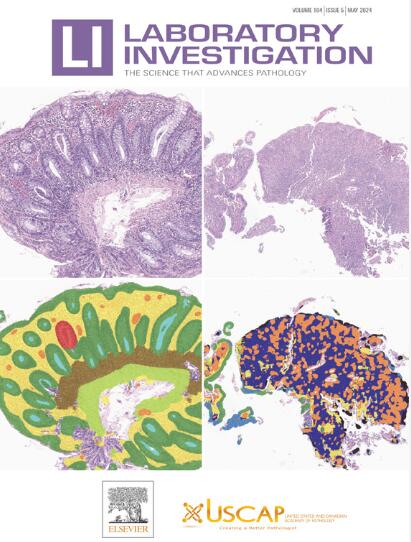芳香烃受体缺乏可上调视网膜色素上皮细胞的细胞间粘附分子1,导致视网膜炎症。
IF 4.2
2区 医学
Q1 MEDICINE, RESEARCH & EXPERIMENTAL
引用次数: 0
摘要
视网膜色素上皮细胞(RPE)位于光感受器和脉络膜之间,在维持视网膜健康和功能中起着至关重要的作用。它们作为免疫抑制屏障,阻止免疫细胞从脉络膜渗透。视网膜炎症有助于各种眼部疾病的发展。芳烃受体(AHR)是一种成熟的配体依赖性转录因子,在配体结合后介导有效的抗炎信号。在几种对视网膜有负面影响的情况下,AHR的表达明显减少。我们假设AHR蛋白丢失可能损害RPE细胞功能,使其向促炎表型转变。在这项研究中,我们研究了AHR敲除(AHR- ko)激活的促炎途径,并检查了AHR- ko小鼠的相关视网膜表型变化。我们的研究结果表明,AHR缺乏可能会增强αvβ3整合素、细胞外信号调节激酶(ERK1/2)和核因子κB p65亚基(NF-κB)的活性,导致细胞间粘附分子1 (ICAM1)的上调,促进单核细胞的体外粘附。将ahr -绿色荧光蛋白导入AHR-KO RPE细胞或用靶向αvβ3 (cycloRGDfk)、局灶黏附激酶(PF573228)、磷脂酶C (U73122)、ERK1/2 (U0126)和NF-κB (Bay11-7082)的药物抑制剂预处理细胞可阻止ICAM1在AHR-KO RPE细胞中的诱导。这些结果表明促炎途径是由AHR缺乏驱动的。在AHR- ko小鼠中,视网膜组织显示ICAM1积累、小胶质细胞激活和迁移,表明AHR缺乏导致慢性视网膜炎症。这些小鼠也表现出早发性视网膜电图变性。总的来说,我们的数据支持AHR在维持RPE细胞生理和视网膜健康方面的保护作用。本文章由计算机程序翻译,如有差异,请以英文原文为准。
Aryl Hydrocarbon Receptor Deficiency Upregulates Intercellular Adhesion Molecule 1 in Retinal Pigment Epithelial Cells and Contributes to Retinal Inflammation
Retinal pigment epithelium (RPE) cells, located between the photoreceptors and choroid, play a crucial role in maintaining retinal health and function. They act as immunosuppressive barriers, preventing immune cell infiltration from the choroid. Retinal inflammation contributes to the development of various ocular diseases. The aryl hydrocarbon receptor (AHR) is a well-established ligand-dependent transcription factor that mediates potent anti-inflammatory signals following ligand binding. AHR expression is notably reduced under several conditions that negatively affect the retina. We hypothesized that AHR protein loss may impair RPE cell function, shifting them toward a proinflammatory phenotype. In this study, we investigated the proinflammatory pathways activated by AHR knockout (AHR-KO) and examined associated retinal phenotypic changes in AHR-KO mice. Our findings suggest that AHR deficiency may enhance the activity of αvβ3-integrin, extracellular signal–regulated kinase 1/2, and p65 subunit of nuclear factor kappa B, leading to an upregulation of intercellular adhesion molecule 1 (ICAM1) and promoting monocyte adhesion in vitro. Introducing an AHR-green fluorescent protein into AHR-KO RPE cells or pretreating the cells with pharmacologic inhibitors targeting αvβ3 (cyclo[RGDfk]), focal adhesion kinase (PF573228), phospholipase C (U73122), extracellular signal–regulated kinase 1/2 (U0126), and nuclear factor kappa B (Bay11-7082) prevented ICAM1 induction in AHR-KO RPE cells. These results suggest that the proinflammatory pathway is driven by AHR deficiency. In AHR-KO mice, retinal tissues showed ICAM1 accumulation, microglial activation, and migration, indicating chronic retinal inflammation because of AHR deficiency. These mice also displayed early-onset electroretinogram degeneration. Collectively, our data support the protective role of AHR in maintaining RPE cell physiology and retinal health.
求助全文
通过发布文献求助,成功后即可免费获取论文全文。
去求助
来源期刊

Laboratory Investigation
医学-病理学
CiteScore
8.30
自引率
0.00%
发文量
125
审稿时长
2 months
期刊介绍:
Laboratory Investigation is an international journal owned by the United States and Canadian Academy of Pathology. Laboratory Investigation offers prompt publication of high-quality original research in all biomedical disciplines relating to the understanding of human disease and the application of new methods to the diagnosis of disease. Both human and experimental studies are welcome.
 求助内容:
求助内容: 应助结果提醒方式:
应助结果提醒方式:


